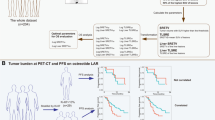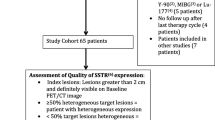Abstract
Purpose
Our aim was to assess the prognostic and predictive value of somatostatin receptor 2 (sstr2) in neuroendocrine tumors (NETs).
Methods
We established a tissue microarray and imaging database from NET patients that received sstr2-targeted radiopeptide therapy with yttrium-90-DOTATOC, lutetium-177-DOTATOC or alternative treatment. We used univariate and multivariate analyses to identify prognostic and predictive markers for overall survival, including sstr2-imaging and sstr2-immunohistochemistry.
Results
We included a total of 279 patients. In these patients, sstr2-immunohistochemistry was an independent prognostic marker for overall survival (HR: 0.82, 95 % CI: 0.67 – 0.99, n = 279, p = 0.037). In DOTATOC patients, sstr2-expression on immunohistochemistry correlated with tumor uptake on sstr2-imaging (n = 170, p < 0.001); however, sstr2-imaging showed a higher prognostic accuracy (positive predictive value: +27 %, 95 % CI: 3 – 56 %, p = 0.025). Sstr2-expression did not predict a benefit of DOTATOC over alternative treatment (p = 0.93).
Conclusions
Our results suggest sstr2 as an independent prognostic marker in NETs. Sstr2-immunohistochemistry correlates with sstr2-imaging; however, sstr2-imaging is more accurate for determining the individual prognosis.




Similar content being viewed by others
References
Kwekkeboom DJ, de Herder WW, Kam BL, van Eijck CH, van Essen M, Kooij PP, et al. Treatment with the radiolabeled somatostatin analog [177 Lu-DOTA 0, Tyr3]octreotate: toxicity, efficacy, and survival. J Clin Oncol: Off J Am Soc Clin Oncol. 2008;26:2124–30. doi:10.1200/JCO.2007.15.2553.
Imhof A, Brunner P, Marincek N, Briel M, Schindler C, Rasch H, et al. Response, survival, and long-term toxicity after therapy with the radiolabeled somatostatin analogue [90Y-DOTA]-TOC in metastasized neuroendocrine cancers. J Clin Oncol: Off J Am Soc Clin Oncol. 2011;29:2416–23. doi:10.1200/JCO.2010.33.7873.
Villard L, Romer A, Marincek N, Brunner P, Koller MT, Schindler C, et al. Cohort study of somatostatin-based radiopeptide therapy with [(90)Y-DOTA]-TOC versus [(90)Y-DOTA]-TOC plus [(177)Lu-DOTA]-TOC in neuroendocrine cancers. J Clin Oncol: Off J Am Soc Clin Oncol. 2012;30:1100–6. doi:10.1200/JCO.2011.37.2151.
Romer A, Seiler D, Marincek N, Brunner P, Koller MT, Ng QK, et al. Somatostatin-based radiopeptide therapy with [177Lu-DOTA]-TOC versus [90Y-DOTA]-TOC in neuroendocrine tumours. Eur J Nucl Med Mol Imaging. 2014;41:214–22. doi:10.1007/s00259-013-2559-8.
Marinoni I, Kurrer AS, Vassella E, Dettmer M, Rudolph T, Banz V, et al. Loss of DAXX and ATRX are associated with chromosome instability and reduced survival of patients with pancreatic neuroendocrine tumors. Gastroenterology. 2014;146:453–60. doi:10.1053/j.gastro.2013.10.020. e5.
Iten F, Muller B, Schindler C, Rochlitz C, Oertli D, Macke HR, et al. Response to [90Yttrium-DOTA]-TOC treatment is associated with long-term survival benefit in metastasized medullary thyroid cancer: a phase II clinical trial. Clin Cancer Res: Off J Am Assoc Cancer Res. 2007;13:6696–702. doi:10.1158/1078-0432.CCR-07-0935.
Iten F, Muller B, Schindler C, Rasch H, Rochlitz C, Oertli D, et al. [(90)Yttrium-DOTA]-TOC response is associated with survival benefit in iodine-refractory thyroid cancer: long-term results of a phase 2 clinical trial. Cancer. 2009;115:2052–62. doi:10.1002/cncr.24272.
Korner M, Waser B, Schonbrunn A, Perren A, Reubi JC. Somatostatin receptor subtype 2A immunohistochemistry using a new monoclonal antibody selects tumors suitable for in vivo somatostatin receptor targeting. Am J Surg Pathol. 2012;36:242–52. doi:10.1097/PAS.0b013e31823d07f3.
Rindi G, Arnold R, Bosman F, Capella C, Klimstra D. Nomenclature and classification of neuroendocrine neoplasms of the digestive system. In: Bosman F, Hruban R, Theise N, editors. WHO classification of tumors of the digestive system. 4th ed. Lyon: International Agency for Research on Cancer; 2010. p. 13–4.
Moskowitz CS, Pepe MS. Quantifying and comparing the accuracy of binary biomarkers when predicting a failure time outcome. Stat Med. 2004;23:1555–70. doi:10.1002/sim.1747.
McShane LM, Altman DG, Sauerbrei W, Taube SE, Gion M, Clark GM, et al. REporting recommendations for tumor MARKer prognostic studies (REMARK). Nat Clin Pract Oncol. 2005;2:416–22.
Kim HS, Lee HS, Kim WH. Clinical significance of protein expression of cyclooxygenase-2 and somatostatin receptors in gastroenteropancreatic neuroendocrine tumors. Cancer Res Treat: Off J Kor Cancer Assoc. 2011;43:181–8. doi:10.4143/crt.2011.43.3.181.
Asnacios A, Courbon F, Rochaix P, Bauvin E, Cances-Lauwers V, Susini C, et al. Indium-111-pentetreotide scintigraphy and somatostatin receptor subtype 2 expression: new prognostic factors for malignant well-differentiated endocrine tumors. J Clin Oncol: Off J Am Soc Clin Oncol. 2008;26:963–70. doi:10.1200/JCO.2007.12.7431.
Strosberg JR, Wolin EM, Chasen B, Kulke MH, Bushnell DL, Caplin ME, et al. NETTER-1 phase III: Progression-free survival, radiographic response, and preliminary overall survival results in patients with midgut neuroendocrine tumors treated with 177-Lu-Dotatate. J Clin Oncol: Off J Am Soc Clin Oncol. 2016;34.
Kunikowska J, Krolicki L, Hubalewska-Dydejczyk A, Mikolajczak R, Sowa-Staszczak A, Pawlak D. Clinical results of radionuclide therapy of neuroendocrine tumours with 90Y-DOTATATE and tandem 90Y/177Lu-DOTATATE: which is a better therapy option? Eur J Nucl Med Mol Imaging. 2011;38:1788–97. doi:10.1007/s00259-011-1833-x.
Acknowledgements
We are grateful to our nursing, laboratory, and technical staff for their support in patient care, preparation of radiopharmaceuticals, and acquisition of scans. Furthermore, we would like to thank Christoph Stettler for his valuable input on the manuscript. All authors declare no potential conflicts of interest.
HRM, MB, AP and MAW were supported by the Swiss National Science Foundation
Author information
Authors and Affiliations
Corresponding author
Ethics declarations
The authors declare no potential conflicts of interest. All procedures performed in this study were in accordance with the ethical standards of the institutional and national research committee and with the 1964 Helsinki Declaration and its later amendments or comparable ethical standards. Informed consent was obtained from all individual participants included in the study.
Additional information
Philippe Brunner and Ann-Catherine Jörg contributed equally to this work.
Rights and permissions
About this article
Cite this article
Brunner, P., Jörg, AC., Glatz, K. et al. The prognostic and predictive value of sstr2-immunohistochemistry and sstr2-targeted imaging in neuroendocrine tumors. Eur J Nucl Med Mol Imaging 44, 468–475 (2017). https://doi.org/10.1007/s00259-016-3486-2
Received:
Accepted:
Published:
Issue Date:
DOI: https://doi.org/10.1007/s00259-016-3486-2




